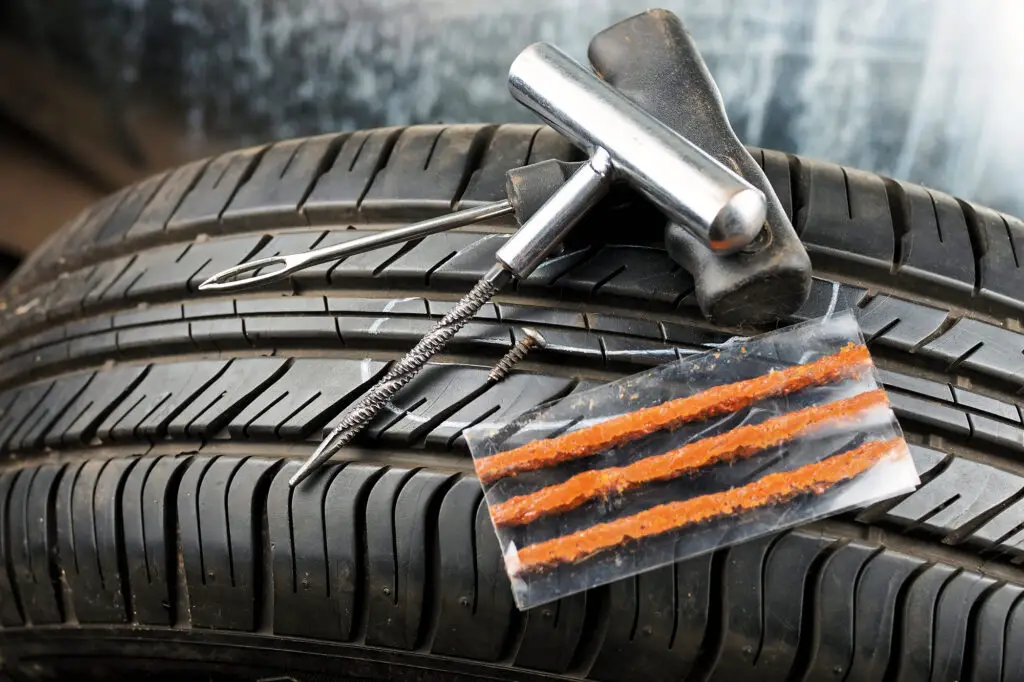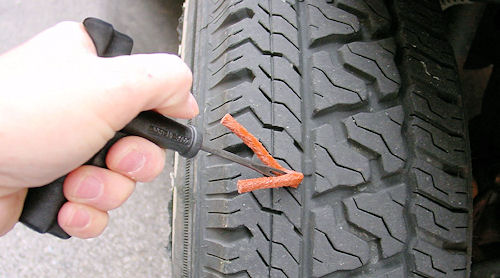If a tire plug won’t go in, the hole may be too small or irregular, or the plug could be the wrong size. Ensure the puncture is clean and the correct tools are used.
A flat tire can quickly derail your day, and many drivers opt for a quick, temporary fix by using a tire plug. This method allows you to seal small punctures in the tire and continue driving until you can get a more permanent solution. However, there are times when the tire plug simply won’t go in, leaving you frustrated and unsure of how to proceed. If you’re facing this issue, you’re not alone.
In this blog post, we will discuss why a tire plug might not go in and how to troubleshoot the issue effectively.

Contents
Why the Tire Plug Won’t Go In?
A tire plug might not go in for a variety of reasons, ranging from issues with the puncture itself to problems with the tools or the technique being used. Below are some common factors that could be causing the issue.
1. Wrong Type of Plug or Tool
Tire plugs come in various sizes and materials, but not all plugs are suitable for all tires. There are different types of tire repair plugs: cylindrical plugs, rope plugs, and rubber plugs. Each is designed for specific types of punctures.
- Cylindrical Plugs: These are solid rubber plugs that need to be inserted with a special insertion tool.
- Rope Plugs: These are long, string-like plugs that are inserted using a spiral reaming tool.
- Rubber Plugs: Similar to rope plugs but made of more flexible rubber material, which can work better for larger punctures.
Make sure you are using the correct type of plug for your tire’s size and the nature of the puncture. The wrong plug or tool can prevent the plug from fitting or sealing properly.
2. The Puncture Is Too Large
Tire plugs are designed for small punctures, typically no larger than 1/4 inch in diameter. If the puncture is too large, the plug may not fit or seal effectively. A large puncture might require a more permanent repair, such as a patch or tire replacement. If the plug won’t go in, it might be because the hole exceeds the capacity of the plug, and trying to force it in could further damage the tire.
3. The Hole Is Not Clean
For the plug to fit and create an airtight seal, the hole must be clean. Dirt, debris, and any moisture inside the hole can obstruct the plug’s insertion or make it difficult for the plug to seal properly. If the puncture is dirty or rusty, using a reaming tool to clean the hole before inserting the plug is crucial.
4. Inserting the Plug at the Wrong Angle
If you are not inserting the plug at the correct angle, it might not go in properly. The plug should be inserted directly into the puncture hole at a straight angle, and the insertion tool should be perpendicular to the surface of the tire. If you try to insert the plug at an angle, the plug may bend or break, making it difficult to install.
5. The Plug Is Too Big for the Hole
Sometimes, the plug you’re using is simply too big for the puncture. If the hole is small and the plug is too thick, it will be difficult to insert. In such cases, trimming the plug down to a smaller size may help. Alternatively, a different type of plug might be needed.
6. The Tire Is Over-Inflated
If the tire is over-inflated when attempting to insert the plug, the air pressure inside may push against the plug, making it difficult to insert. It’s important to let some air out of the tire to reduce the pressure before attempting to plug the hole.
7. Using Low-Quality Plugs
Not all tire plugs are created equal. Lower-quality plugs may be difficult to work with, especially if they are made from inferior materials that are harder to insert or less effective at sealing the puncture. Invest in a high-quality plug kit from a reputable brand to ensure a smoother and more reliable repair process.
Step-by-Step Guide for Successfully Plugging a Tire
If you’re experiencing trouble with a tire plug won’t go in, follow these steps to troubleshoot and fix the problem.
Step 1: Assess the Puncture
Before attempting to plug the tire, inspect the puncture carefully. If the hole is larger than 1/4 inch or located on the sidewall or shoulder of the tire, plugging it may not be effective, and you might need to consult a professional for a more permanent repair. Read more about Is A Tire Plug A Permanent Fix?
Step 2: Gather the Right Tools and Materials
Ensure you have the right tools and materials for the job. You will need:
- A tire plug kit (including reaming tool, insertion tool, plugs)
- Air compressor or tire inflator
- Lubricant (if needed)
- A valve core remover (optional, for letting air out of the tire)
Step 3: Remove the Tire Valve Core (If Needed)
If your tire is over-inflated, use a valve core remover to release some air from the tire. Reducing the tire pressure will help make it easier to insert the plug.
Step 4: Clean the Puncture Area
Use the reaming tool from your kit to clean the puncture. Insert the tool into the hole and twist it back and forth to remove debris and smooth the edges. This step is essential to ensure the plug fits properly and forms an airtight seal.
Step 5: Insert the Plug
Take a plug from the kit and insert it into the insertion tool. Lubricate the plug lightly (with tire repair lubricant or soapy water) to ease the insertion process. Insert the tool into the puncture and push the plug into the hole with steady, even pressure. Once the plug is in, release the tool and trim any excess plug material.
Step 6: Inflate the Tire
Reinflate the tire to the recommended pressure level and check for any air leaks. If the plug has been inserted properly, the tire should hold air without any issues. If the tire is still leaking, the plug may not have sealed correctly, and you may need to try again or consider a different repair method.

When to Seek Professional Help
If the tire plug still won’t go in after following the steps above, it’s important to assess whether the repair is safe. In some cases, a plug might not be enough, and the tire may need a more extensive repair or replacement. Seek professional assistance if:
- The puncture is too large for a plug to seal effectively.
- The plug won’t stay in place or creates an air leak.
- The puncture is located on the sidewall or shoulder of the tire.
A tire repair professional can help determine whether the tire is salvageable or if it needs to be replaced.
Frequently Asked Questions
Here are some FAQs about tire plug won’t go in –
How long can I drive on a plugged tire?
A plugged tire is a temporary solution, and you should drive cautiously. Ideally, you should replace or professionally repair the tire as soon as possible, but it can last for several days or weeks depending on the size and location of the puncture.
Can I use a tire plug on the sidewall?
No, tire plugs should not be used on the sidewall or shoulder of the tire, as these areas are under higher stress and are difficult to repair with a plug. Professional patching or replacement is required for sidewall punctures.
Can I drive immediately after plugging a tire?
After plugging the tire and inflating it, you can drive immediately. However, make sure to check for air leaks and monitor the tire pressure for a while to ensure the repair holds.
How do I know if the plug is sealing properly?
After inserting the plug, inflate the tire and check for any air leaks by spraying soapy water around the puncture. If bubbles appear, the plug hasn’t sealed completely, and you may need to remove it and try again.
Can I use a tire plug more than once?
It’s not recommended to reuse a tire plug, especially for large punctures. Once a tire plug has been used, the integrity of the repair may be compromised. A professional repair or replacement may be necessary after the initial plug fails.
Conclusion
While it’s often a simple and quick fix, plugging a tire isn’t always straightforward. If the tire plug won’t go in, it could be due to several factors, including the size of the puncture, the tools, and the type of plug being used. By following the right procedure and troubleshooting the issue, you can increase the chances of success.
However, always keep in mind that tire plugs are a temporary solution, and it’s essential to replace or professionally repair the tire as soon as possible to ensure your safety on the road.